INNOVATION THEORY 10: Disruptive Innovation at Terracycle - Report
VerifiedAdded on 2022/09/09
|15
|4164
|19
Report
AI Summary
This report delves into the application of disruptive innovation theory, focusing on the company Terracycle. The report begins with an executive summary, followed by an introduction to innovation and the chosen theory. It then explores the principles, processes, benefits, and limitations of disruptive innovation theory. A significant portion of the report is dedicated to evaluating Terracycle's historical development through the lens of the theory, including a company background and an analysis of its business models. The report further applies the theory to suggest potential future development pathways for Terracycle. The report is structured with a table of contents, and concludes with references and an appendix.
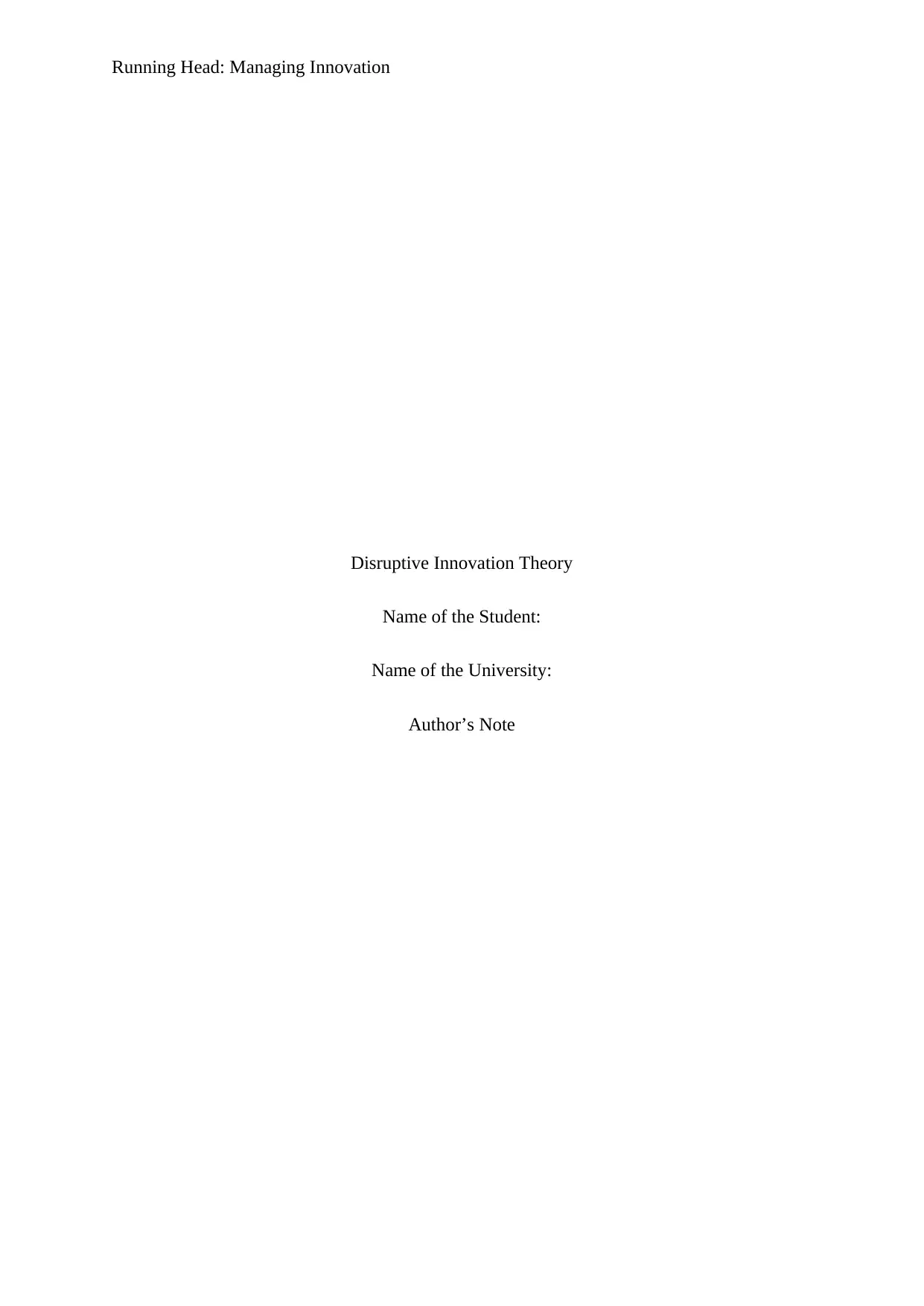
Running Head: Managing Innovation
Disruptive Innovation Theory
Name of the Student:
Name of the University:
Author’s Note
Disruptive Innovation Theory
Name of the Student:
Name of the University:
Author’s Note
Paraphrase This Document
Need a fresh take? Get an instant paraphrase of this document with our AI Paraphraser
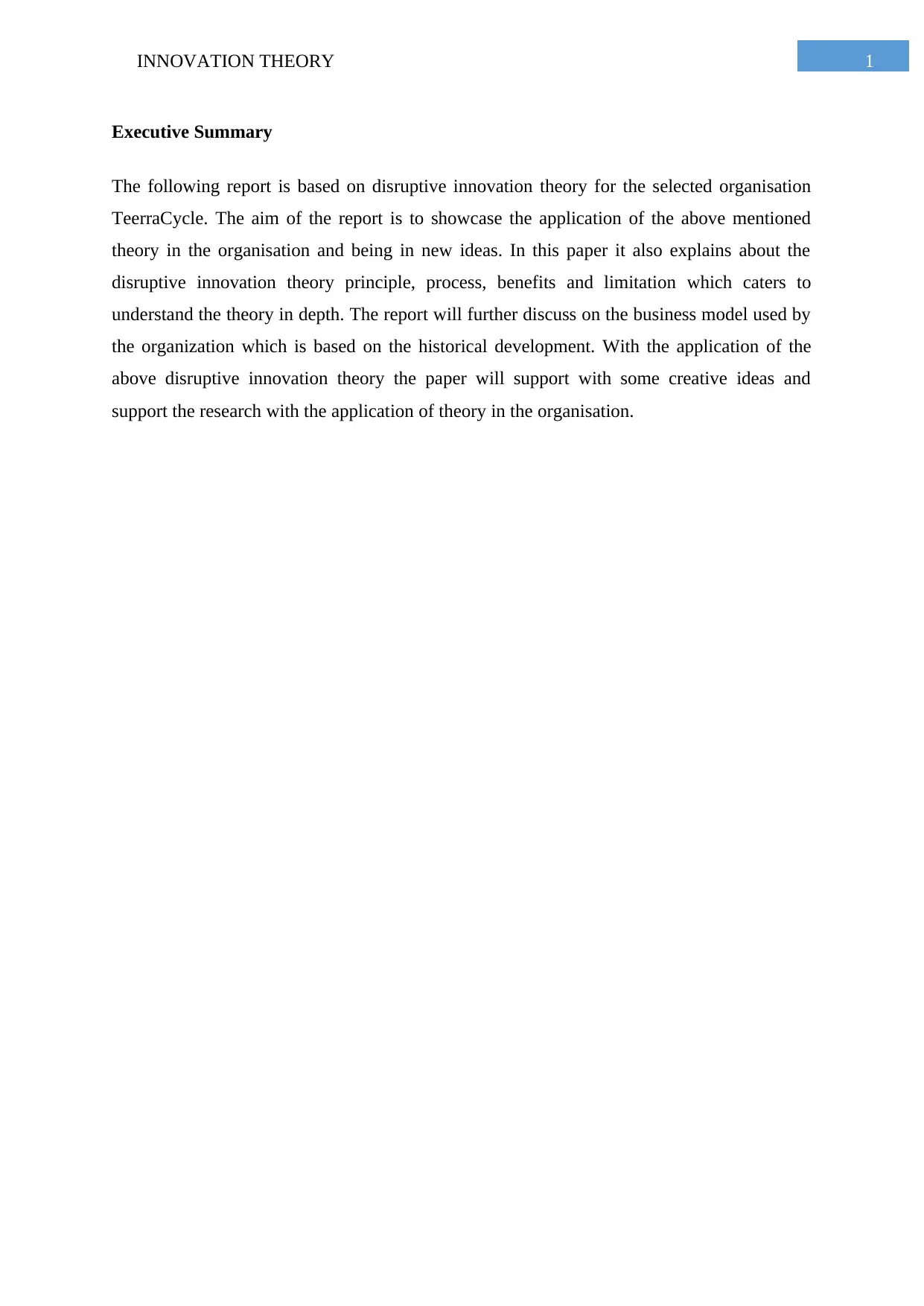
1INNOVATION THEORY
Executive Summary
The following report is based on disruptive innovation theory for the selected organisation
TeerraCycle. The aim of the report is to showcase the application of the above mentioned
theory in the organisation and being in new ideas. In this paper it also explains about the
disruptive innovation theory principle, process, benefits and limitation which caters to
understand the theory in depth. The report will further discuss on the business model used by
the organization which is based on the historical development. With the application of the
above disruptive innovation theory the paper will support with some creative ideas and
support the research with the application of theory in the organisation.
Executive Summary
The following report is based on disruptive innovation theory for the selected organisation
TeerraCycle. The aim of the report is to showcase the application of the above mentioned
theory in the organisation and being in new ideas. In this paper it also explains about the
disruptive innovation theory principle, process, benefits and limitation which caters to
understand the theory in depth. The report will further discuss on the business model used by
the organization which is based on the historical development. With the application of the
above disruptive innovation theory the paper will support with some creative ideas and
support the research with the application of theory in the organisation.
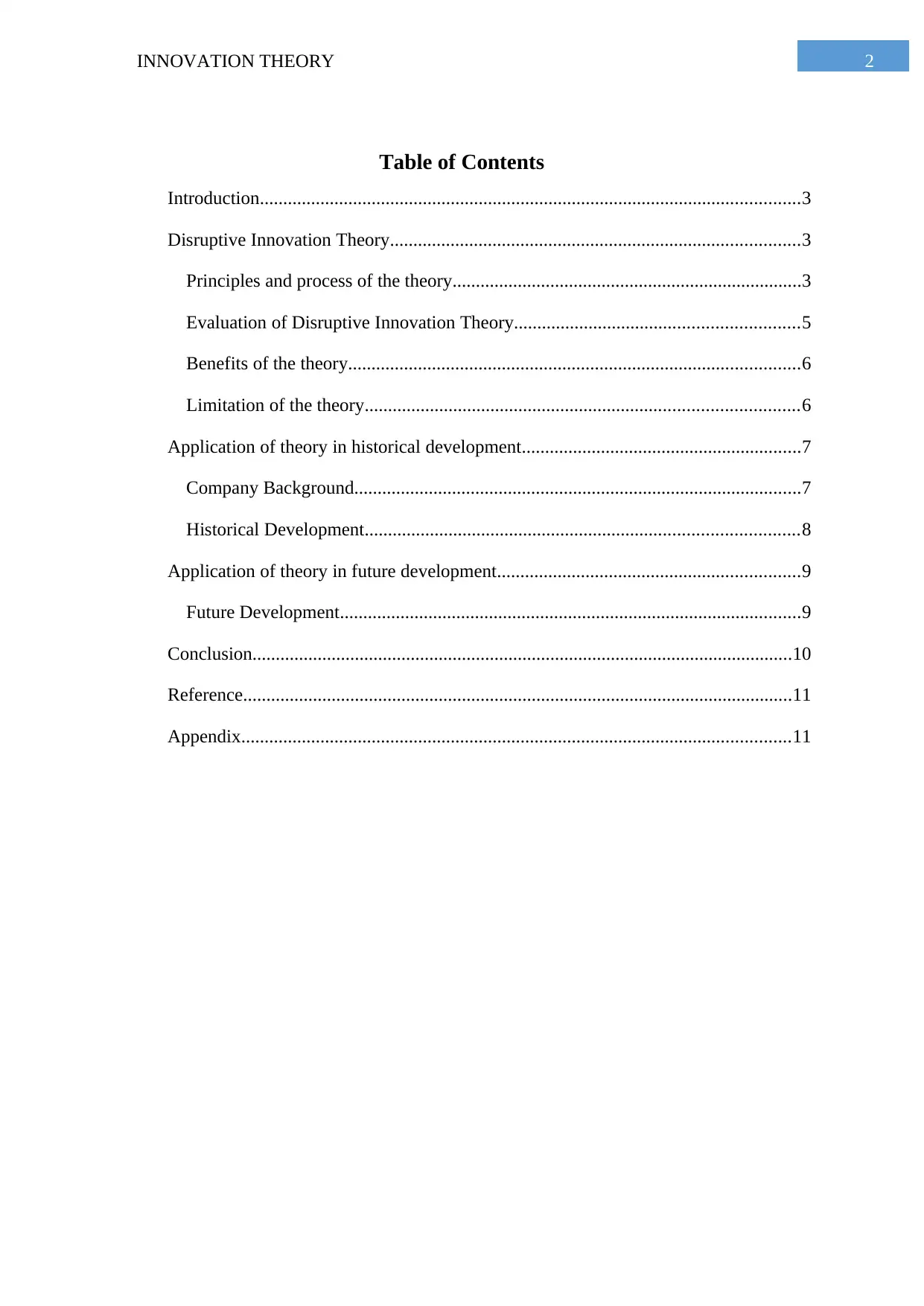
2INNOVATION THEORY
Table of Contents
Introduction....................................................................................................................3
Disruptive Innovation Theory........................................................................................3
Principles and process of the theory...........................................................................3
Evaluation of Disruptive Innovation Theory.............................................................5
Benefits of the theory.................................................................................................6
Limitation of the theory.............................................................................................6
Application of theory in historical development............................................................7
Company Background................................................................................................7
Historical Development.............................................................................................8
Application of theory in future development.................................................................9
Future Development...................................................................................................9
Conclusion....................................................................................................................10
Reference......................................................................................................................11
Appendix......................................................................................................................11
Table of Contents
Introduction....................................................................................................................3
Disruptive Innovation Theory........................................................................................3
Principles and process of the theory...........................................................................3
Evaluation of Disruptive Innovation Theory.............................................................5
Benefits of the theory.................................................................................................6
Limitation of the theory.............................................................................................6
Application of theory in historical development............................................................7
Company Background................................................................................................7
Historical Development.............................................................................................8
Application of theory in future development.................................................................9
Future Development...................................................................................................9
Conclusion....................................................................................................................10
Reference......................................................................................................................11
Appendix......................................................................................................................11
⊘ This is a preview!⊘
Do you want full access?
Subscribe today to unlock all pages.

Trusted by 1+ million students worldwide
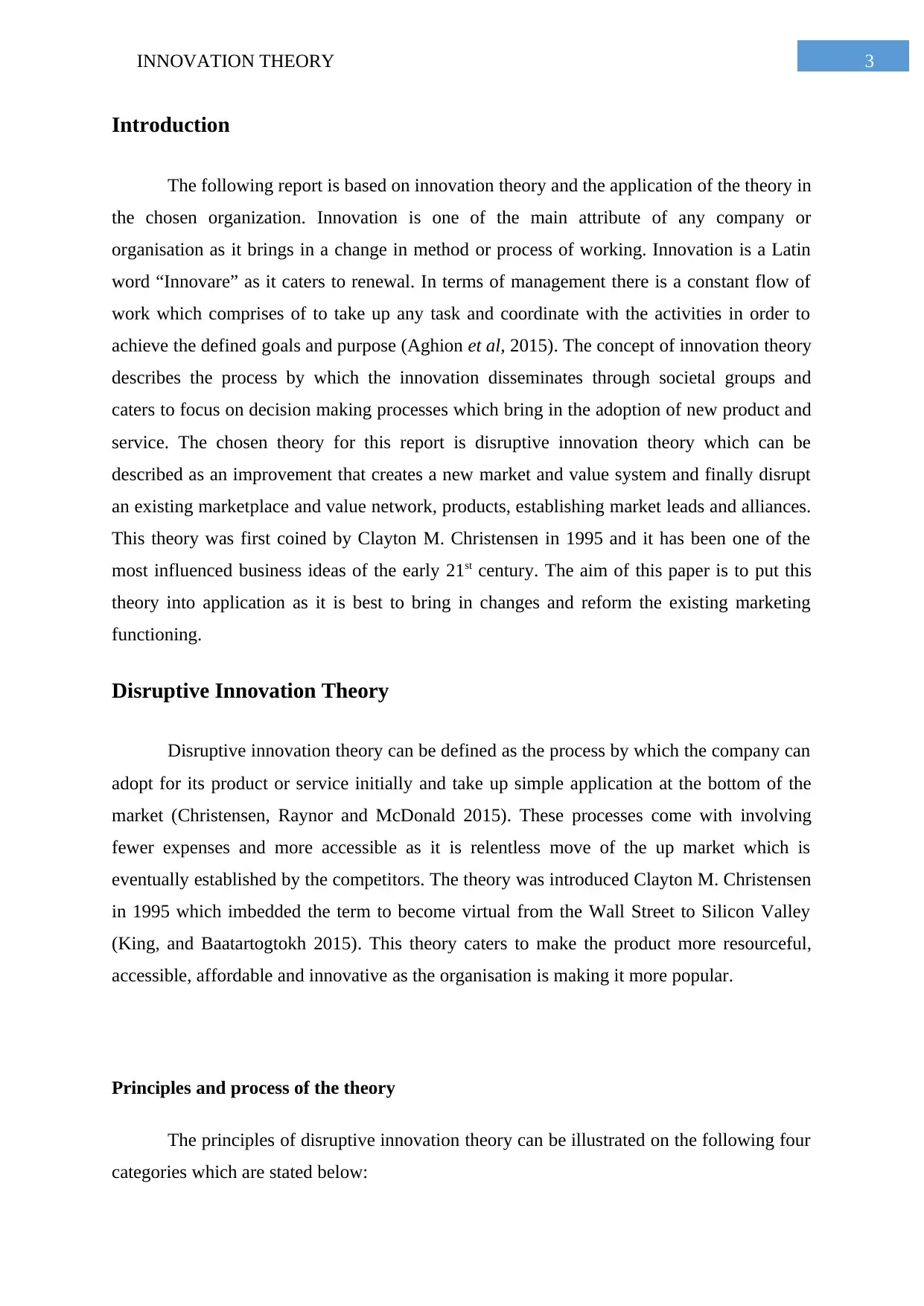
3INNOVATION THEORY
Introduction
The following report is based on innovation theory and the application of the theory in
the chosen organization. Innovation is one of the main attribute of any company or
organisation as it brings in a change in method or process of working. Innovation is a Latin
word “Innovare” as it caters to renewal. In terms of management there is a constant flow of
work which comprises of to take up any task and coordinate with the activities in order to
achieve the defined goals and purpose (Aghion et al, 2015). The concept of innovation theory
describes the process by which the innovation disseminates through societal groups and
caters to focus on decision making processes which bring in the adoption of new product and
service. The chosen theory for this report is disruptive innovation theory which can be
described as an improvement that creates a new market and value system and finally disrupt
an existing marketplace and value network, products, establishing market leads and alliances.
This theory was first coined by Clayton M. Christensen in 1995 and it has been one of the
most influenced business ideas of the early 21st century. The aim of this paper is to put this
theory into application as it is best to bring in changes and reform the existing marketing
functioning.
Disruptive Innovation Theory
Disruptive innovation theory can be defined as the process by which the company can
adopt for its product or service initially and take up simple application at the bottom of the
market (Christensen, Raynor and McDonald 2015). These processes come with involving
fewer expenses and more accessible as it is relentless move of the up market which is
eventually established by the competitors. The theory was introduced Clayton M. Christensen
in 1995 which imbedded the term to become virtual from the Wall Street to Silicon Valley
(King, and Baatartogtokh 2015). This theory caters to make the product more resourceful,
accessible, affordable and innovative as the organisation is making it more popular.
Principles and process of the theory
The principles of disruptive innovation theory can be illustrated on the following four
categories which are stated below:
Introduction
The following report is based on innovation theory and the application of the theory in
the chosen organization. Innovation is one of the main attribute of any company or
organisation as it brings in a change in method or process of working. Innovation is a Latin
word “Innovare” as it caters to renewal. In terms of management there is a constant flow of
work which comprises of to take up any task and coordinate with the activities in order to
achieve the defined goals and purpose (Aghion et al, 2015). The concept of innovation theory
describes the process by which the innovation disseminates through societal groups and
caters to focus on decision making processes which bring in the adoption of new product and
service. The chosen theory for this report is disruptive innovation theory which can be
described as an improvement that creates a new market and value system and finally disrupt
an existing marketplace and value network, products, establishing market leads and alliances.
This theory was first coined by Clayton M. Christensen in 1995 and it has been one of the
most influenced business ideas of the early 21st century. The aim of this paper is to put this
theory into application as it is best to bring in changes and reform the existing marketing
functioning.
Disruptive Innovation Theory
Disruptive innovation theory can be defined as the process by which the company can
adopt for its product or service initially and take up simple application at the bottom of the
market (Christensen, Raynor and McDonald 2015). These processes come with involving
fewer expenses and more accessible as it is relentless move of the up market which is
eventually established by the competitors. The theory was introduced Clayton M. Christensen
in 1995 which imbedded the term to become virtual from the Wall Street to Silicon Valley
(King, and Baatartogtokh 2015). This theory caters to make the product more resourceful,
accessible, affordable and innovative as the organisation is making it more popular.
Principles and process of the theory
The principles of disruptive innovation theory can be illustrated on the following four
categories which are stated below:
Paraphrase This Document
Need a fresh take? Get an instant paraphrase of this document with our AI Paraphraser
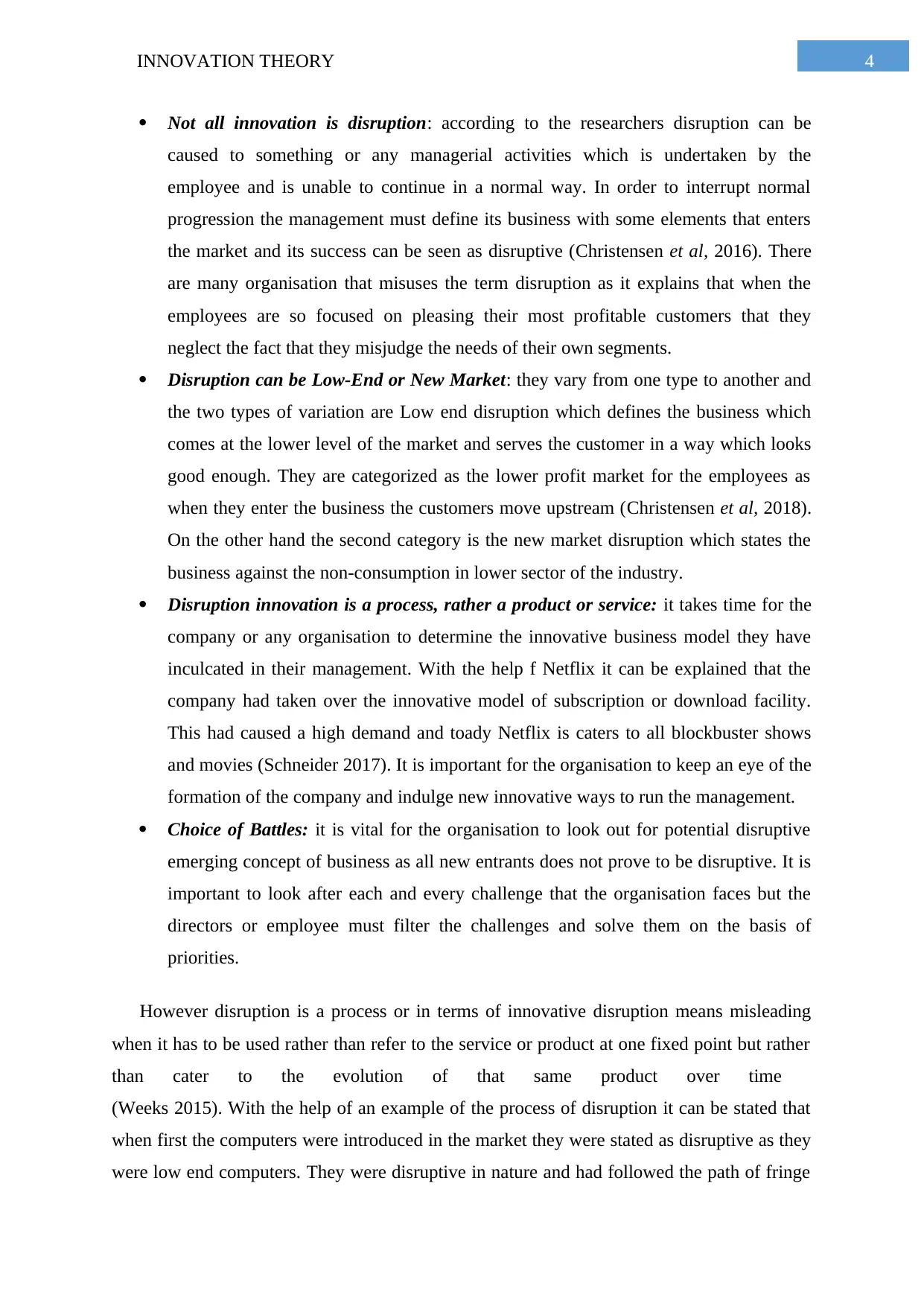
4INNOVATION THEORY
Not all innovation is disruption: according to the researchers disruption can be
caused to something or any managerial activities which is undertaken by the
employee and is unable to continue in a normal way. In order to interrupt normal
progression the management must define its business with some elements that enters
the market and its success can be seen as disruptive (Christensen et al, 2016). There
are many organisation that misuses the term disruption as it explains that when the
employees are so focused on pleasing their most profitable customers that they
neglect the fact that they misjudge the needs of their own segments.
Disruption can be Low-End or New Market: they vary from one type to another and
the two types of variation are Low end disruption which defines the business which
comes at the lower level of the market and serves the customer in a way which looks
good enough. They are categorized as the lower profit market for the employees as
when they enter the business the customers move upstream (Christensen et al, 2018).
On the other hand the second category is the new market disruption which states the
business against the non-consumption in lower sector of the industry.
Disruption innovation is a process, rather a product or service: it takes time for the
company or any organisation to determine the innovative business model they have
inculcated in their management. With the help f Netflix it can be explained that the
company had taken over the innovative model of subscription or download facility.
This had caused a high demand and toady Netflix is caters to all blockbuster shows
and movies (Schneider 2017). It is important for the organisation to keep an eye of the
formation of the company and indulge new innovative ways to run the management.
Choice of Battles: it is vital for the organisation to look out for potential disruptive
emerging concept of business as all new entrants does not prove to be disruptive. It is
important to look after each and every challenge that the organisation faces but the
directors or employee must filter the challenges and solve them on the basis of
priorities.
However disruption is a process or in terms of innovative disruption means misleading
when it has to be used rather than refer to the service or product at one fixed point but rather
than cater to the evolution of that same product over time
(Weeks 2015). With the help of an example of the process of disruption it can be stated that
when first the computers were introduced in the market they were stated as disruptive as they
were low end computers. They were disruptive in nature and had followed the path of fringe
Not all innovation is disruption: according to the researchers disruption can be
caused to something or any managerial activities which is undertaken by the
employee and is unable to continue in a normal way. In order to interrupt normal
progression the management must define its business with some elements that enters
the market and its success can be seen as disruptive (Christensen et al, 2016). There
are many organisation that misuses the term disruption as it explains that when the
employees are so focused on pleasing their most profitable customers that they
neglect the fact that they misjudge the needs of their own segments.
Disruption can be Low-End or New Market: they vary from one type to another and
the two types of variation are Low end disruption which defines the business which
comes at the lower level of the market and serves the customer in a way which looks
good enough. They are categorized as the lower profit market for the employees as
when they enter the business the customers move upstream (Christensen et al, 2018).
On the other hand the second category is the new market disruption which states the
business against the non-consumption in lower sector of the industry.
Disruption innovation is a process, rather a product or service: it takes time for the
company or any organisation to determine the innovative business model they have
inculcated in their management. With the help f Netflix it can be explained that the
company had taken over the innovative model of subscription or download facility.
This had caused a high demand and toady Netflix is caters to all blockbuster shows
and movies (Schneider 2017). It is important for the organisation to keep an eye of the
formation of the company and indulge new innovative ways to run the management.
Choice of Battles: it is vital for the organisation to look out for potential disruptive
emerging concept of business as all new entrants does not prove to be disruptive. It is
important to look after each and every challenge that the organisation faces but the
directors or employee must filter the challenges and solve them on the basis of
priorities.
However disruption is a process or in terms of innovative disruption means misleading
when it has to be used rather than refer to the service or product at one fixed point but rather
than cater to the evolution of that same product over time
(Weeks 2015). With the help of an example of the process of disruption it can be stated that
when first the computers were introduced in the market they were stated as disruptive as they
were low end computers. They were disruptive in nature and had followed the path of fringe
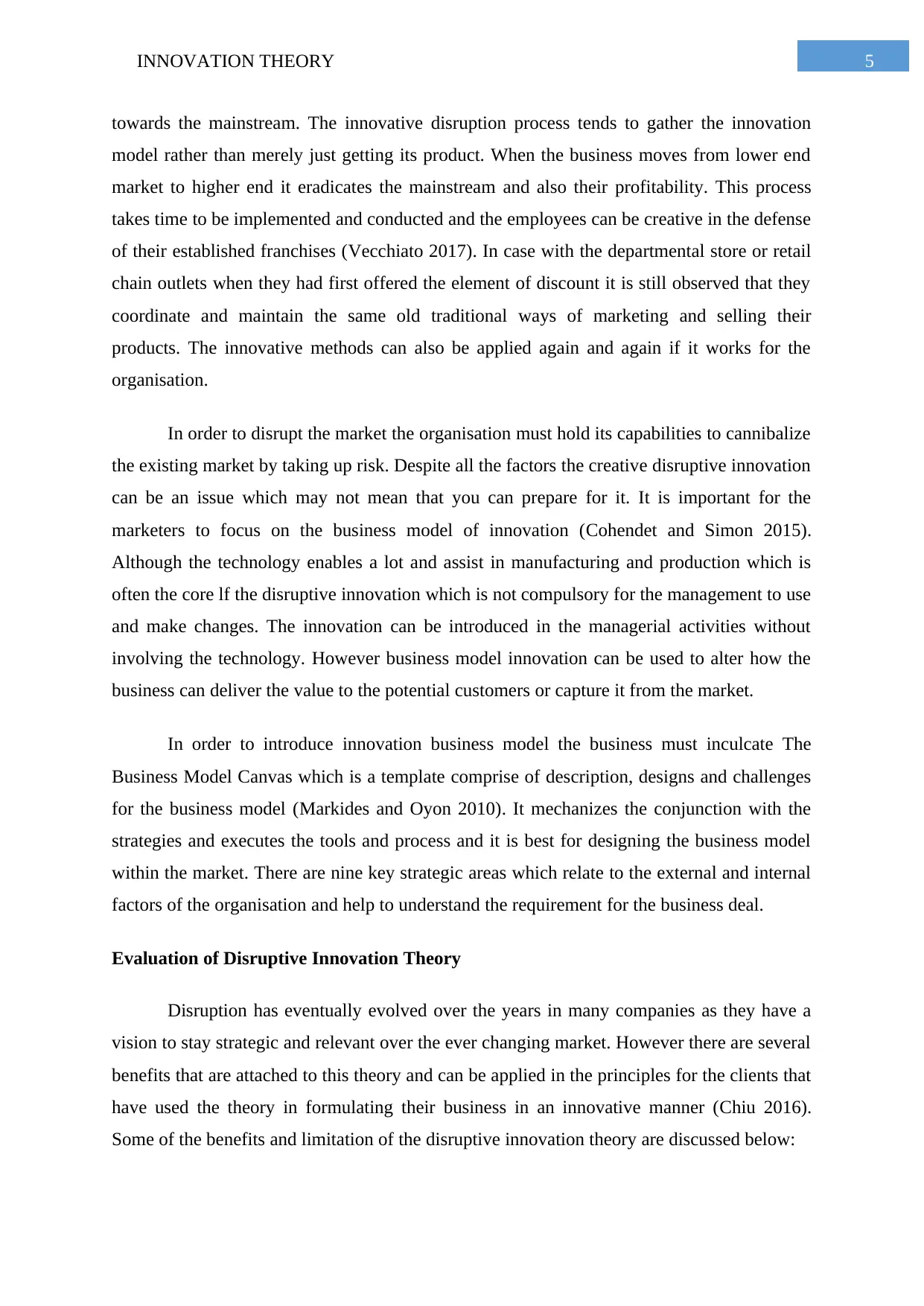
5INNOVATION THEORY
towards the mainstream. The innovative disruption process tends to gather the innovation
model rather than merely just getting its product. When the business moves from lower end
market to higher end it eradicates the mainstream and also their profitability. This process
takes time to be implemented and conducted and the employees can be creative in the defense
of their established franchises (Vecchiato 2017). In case with the departmental store or retail
chain outlets when they had first offered the element of discount it is still observed that they
coordinate and maintain the same old traditional ways of marketing and selling their
products. The innovative methods can also be applied again and again if it works for the
organisation.
In order to disrupt the market the organisation must hold its capabilities to cannibalize
the existing market by taking up risk. Despite all the factors the creative disruptive innovation
can be an issue which may not mean that you can prepare for it. It is important for the
marketers to focus on the business model of innovation (Cohendet and Simon 2015).
Although the technology enables a lot and assist in manufacturing and production which is
often the core lf the disruptive innovation which is not compulsory for the management to use
and make changes. The innovation can be introduced in the managerial activities without
involving the technology. However business model innovation can be used to alter how the
business can deliver the value to the potential customers or capture it from the market.
In order to introduce innovation business model the business must inculcate The
Business Model Canvas which is a template comprise of description, designs and challenges
for the business model (Markides and Oyon 2010). It mechanizes the conjunction with the
strategies and executes the tools and process and it is best for designing the business model
within the market. There are nine key strategic areas which relate to the external and internal
factors of the organisation and help to understand the requirement for the business deal.
Evaluation of Disruptive Innovation Theory
Disruption has eventually evolved over the years in many companies as they have a
vision to stay strategic and relevant over the ever changing market. However there are several
benefits that are attached to this theory and can be applied in the principles for the clients that
have used the theory in formulating their business in an innovative manner (Chiu 2016).
Some of the benefits and limitation of the disruptive innovation theory are discussed below:
towards the mainstream. The innovative disruption process tends to gather the innovation
model rather than merely just getting its product. When the business moves from lower end
market to higher end it eradicates the mainstream and also their profitability. This process
takes time to be implemented and conducted and the employees can be creative in the defense
of their established franchises (Vecchiato 2017). In case with the departmental store or retail
chain outlets when they had first offered the element of discount it is still observed that they
coordinate and maintain the same old traditional ways of marketing and selling their
products. The innovative methods can also be applied again and again if it works for the
organisation.
In order to disrupt the market the organisation must hold its capabilities to cannibalize
the existing market by taking up risk. Despite all the factors the creative disruptive innovation
can be an issue which may not mean that you can prepare for it. It is important for the
marketers to focus on the business model of innovation (Cohendet and Simon 2015).
Although the technology enables a lot and assist in manufacturing and production which is
often the core lf the disruptive innovation which is not compulsory for the management to use
and make changes. The innovation can be introduced in the managerial activities without
involving the technology. However business model innovation can be used to alter how the
business can deliver the value to the potential customers or capture it from the market.
In order to introduce innovation business model the business must inculcate The
Business Model Canvas which is a template comprise of description, designs and challenges
for the business model (Markides and Oyon 2010). It mechanizes the conjunction with the
strategies and executes the tools and process and it is best for designing the business model
within the market. There are nine key strategic areas which relate to the external and internal
factors of the organisation and help to understand the requirement for the business deal.
Evaluation of Disruptive Innovation Theory
Disruption has eventually evolved over the years in many companies as they have a
vision to stay strategic and relevant over the ever changing market. However there are several
benefits that are attached to this theory and can be applied in the principles for the clients that
have used the theory in formulating their business in an innovative manner (Chiu 2016).
Some of the benefits and limitation of the disruptive innovation theory are discussed below:
⊘ This is a preview!⊘
Do you want full access?
Subscribe today to unlock all pages.

Trusted by 1+ million students worldwide
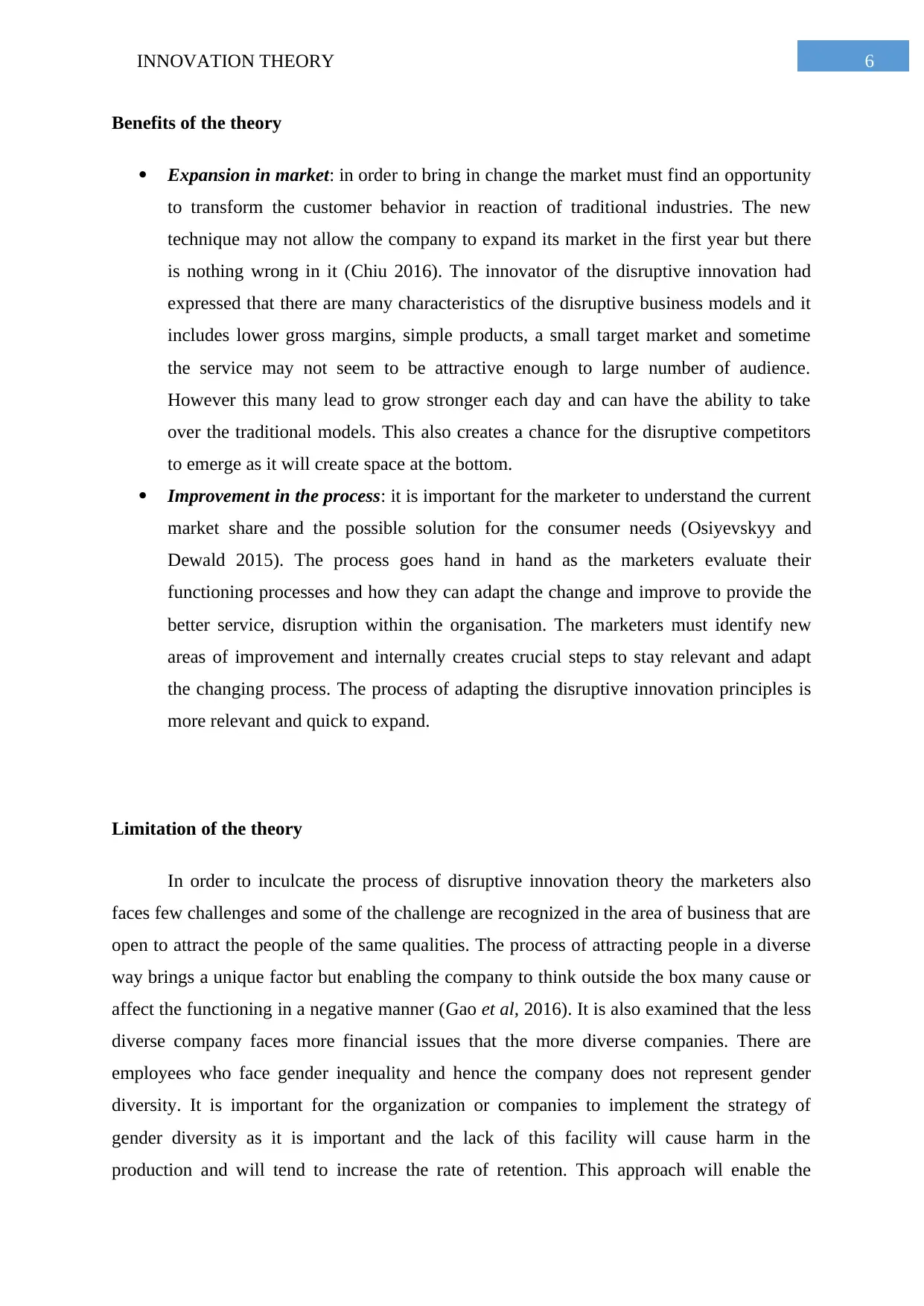
6INNOVATION THEORY
Benefits of the theory
Expansion in market: in order to bring in change the market must find an opportunity
to transform the customer behavior in reaction of traditional industries. The new
technique may not allow the company to expand its market in the first year but there
is nothing wrong in it (Chiu 2016). The innovator of the disruptive innovation had
expressed that there are many characteristics of the disruptive business models and it
includes lower gross margins, simple products, a small target market and sometime
the service may not seem to be attractive enough to large number of audience.
However this many lead to grow stronger each day and can have the ability to take
over the traditional models. This also creates a chance for the disruptive competitors
to emerge as it will create space at the bottom.
Improvement in the process: it is important for the marketer to understand the current
market share and the possible solution for the consumer needs (Osiyevskyy and
Dewald 2015). The process goes hand in hand as the marketers evaluate their
functioning processes and how they can adapt the change and improve to provide the
better service, disruption within the organisation. The marketers must identify new
areas of improvement and internally creates crucial steps to stay relevant and adapt
the changing process. The process of adapting the disruptive innovation principles is
more relevant and quick to expand.
Limitation of the theory
In order to inculcate the process of disruptive innovation theory the marketers also
faces few challenges and some of the challenge are recognized in the area of business that are
open to attract the people of the same qualities. The process of attracting people in a diverse
way brings a unique factor but enabling the company to think outside the box many cause or
affect the functioning in a negative manner (Gao et al, 2016). It is also examined that the less
diverse company faces more financial issues that the more diverse companies. There are
employees who face gender inequality and hence the company does not represent gender
diversity. It is important for the organization or companies to implement the strategy of
gender diversity as it is important and the lack of this facility will cause harm in the
production and will tend to increase the rate of retention. This approach will enable the
Benefits of the theory
Expansion in market: in order to bring in change the market must find an opportunity
to transform the customer behavior in reaction of traditional industries. The new
technique may not allow the company to expand its market in the first year but there
is nothing wrong in it (Chiu 2016). The innovator of the disruptive innovation had
expressed that there are many characteristics of the disruptive business models and it
includes lower gross margins, simple products, a small target market and sometime
the service may not seem to be attractive enough to large number of audience.
However this many lead to grow stronger each day and can have the ability to take
over the traditional models. This also creates a chance for the disruptive competitors
to emerge as it will create space at the bottom.
Improvement in the process: it is important for the marketer to understand the current
market share and the possible solution for the consumer needs (Osiyevskyy and
Dewald 2015). The process goes hand in hand as the marketers evaluate their
functioning processes and how they can adapt the change and improve to provide the
better service, disruption within the organisation. The marketers must identify new
areas of improvement and internally creates crucial steps to stay relevant and adapt
the changing process. The process of adapting the disruptive innovation principles is
more relevant and quick to expand.
Limitation of the theory
In order to inculcate the process of disruptive innovation theory the marketers also
faces few challenges and some of the challenge are recognized in the area of business that are
open to attract the people of the same qualities. The process of attracting people in a diverse
way brings a unique factor but enabling the company to think outside the box many cause or
affect the functioning in a negative manner (Gao et al, 2016). It is also examined that the less
diverse company faces more financial issues that the more diverse companies. There are
employees who face gender inequality and hence the company does not represent gender
diversity. It is important for the organization or companies to implement the strategy of
gender diversity as it is important and the lack of this facility will cause harm in the
production and will tend to increase the rate of retention. This approach will enable the
Paraphrase This Document
Need a fresh take? Get an instant paraphrase of this document with our AI Paraphraser
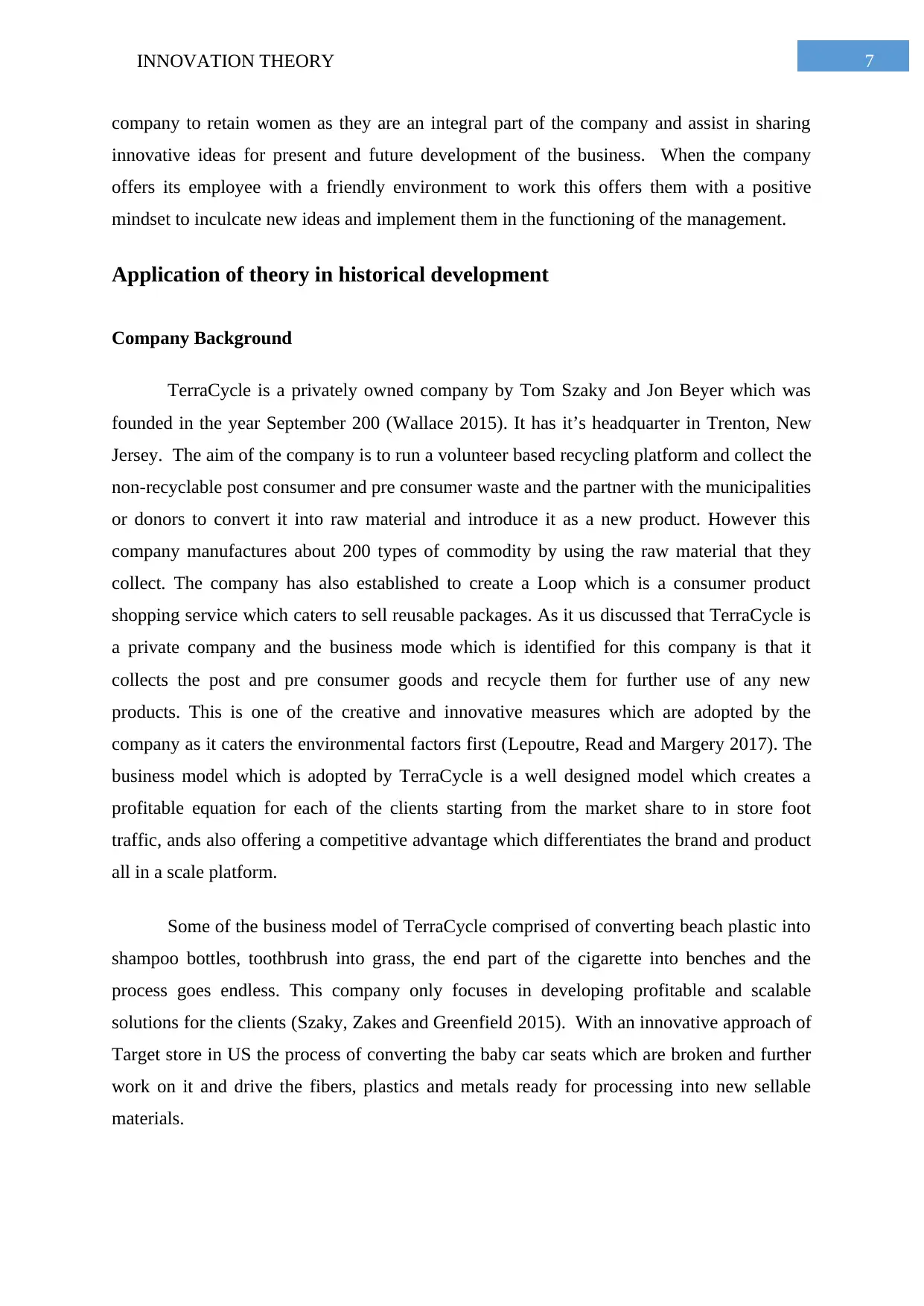
7INNOVATION THEORY
company to retain women as they are an integral part of the company and assist in sharing
innovative ideas for present and future development of the business. When the company
offers its employee with a friendly environment to work this offers them with a positive
mindset to inculcate new ideas and implement them in the functioning of the management.
Application of theory in historical development
Company Background
TerraCycle is a privately owned company by Tom Szaky and Jon Beyer which was
founded in the year September 200 (Wallace 2015). It has it’s headquarter in Trenton, New
Jersey. The aim of the company is to run a volunteer based recycling platform and collect the
non-recyclable post consumer and pre consumer waste and the partner with the municipalities
or donors to convert it into raw material and introduce it as a new product. However this
company manufactures about 200 types of commodity by using the raw material that they
collect. The company has also established to create a Loop which is a consumer product
shopping service which caters to sell reusable packages. As it us discussed that TerraCycle is
a private company and the business mode which is identified for this company is that it
collects the post and pre consumer goods and recycle them for further use of any new
products. This is one of the creative and innovative measures which are adopted by the
company as it caters the environmental factors first (Lepoutre, Read and Margery 2017). The
business model which is adopted by TerraCycle is a well designed model which creates a
profitable equation for each of the clients starting from the market share to in store foot
traffic, ands also offering a competitive advantage which differentiates the brand and product
all in a scale platform.
Some of the business model of TerraCycle comprised of converting beach plastic into
shampoo bottles, toothbrush into grass, the end part of the cigarette into benches and the
process goes endless. This company only focuses in developing profitable and scalable
solutions for the clients (Szaky, Zakes and Greenfield 2015). With an innovative approach of
Target store in US the process of converting the baby car seats which are broken and further
work on it and drive the fibers, plastics and metals ready for processing into new sellable
materials.
company to retain women as they are an integral part of the company and assist in sharing
innovative ideas for present and future development of the business. When the company
offers its employee with a friendly environment to work this offers them with a positive
mindset to inculcate new ideas and implement them in the functioning of the management.
Application of theory in historical development
Company Background
TerraCycle is a privately owned company by Tom Szaky and Jon Beyer which was
founded in the year September 200 (Wallace 2015). It has it’s headquarter in Trenton, New
Jersey. The aim of the company is to run a volunteer based recycling platform and collect the
non-recyclable post consumer and pre consumer waste and the partner with the municipalities
or donors to convert it into raw material and introduce it as a new product. However this
company manufactures about 200 types of commodity by using the raw material that they
collect. The company has also established to create a Loop which is a consumer product
shopping service which caters to sell reusable packages. As it us discussed that TerraCycle is
a private company and the business mode which is identified for this company is that it
collects the post and pre consumer goods and recycle them for further use of any new
products. This is one of the creative and innovative measures which are adopted by the
company as it caters the environmental factors first (Lepoutre, Read and Margery 2017). The
business model which is adopted by TerraCycle is a well designed model which creates a
profitable equation for each of the clients starting from the market share to in store foot
traffic, ands also offering a competitive advantage which differentiates the brand and product
all in a scale platform.
Some of the business model of TerraCycle comprised of converting beach plastic into
shampoo bottles, toothbrush into grass, the end part of the cigarette into benches and the
process goes endless. This company only focuses in developing profitable and scalable
solutions for the clients (Szaky, Zakes and Greenfield 2015). With an innovative approach of
Target store in US the process of converting the baby car seats which are broken and further
work on it and drive the fibers, plastics and metals ready for processing into new sellable
materials.
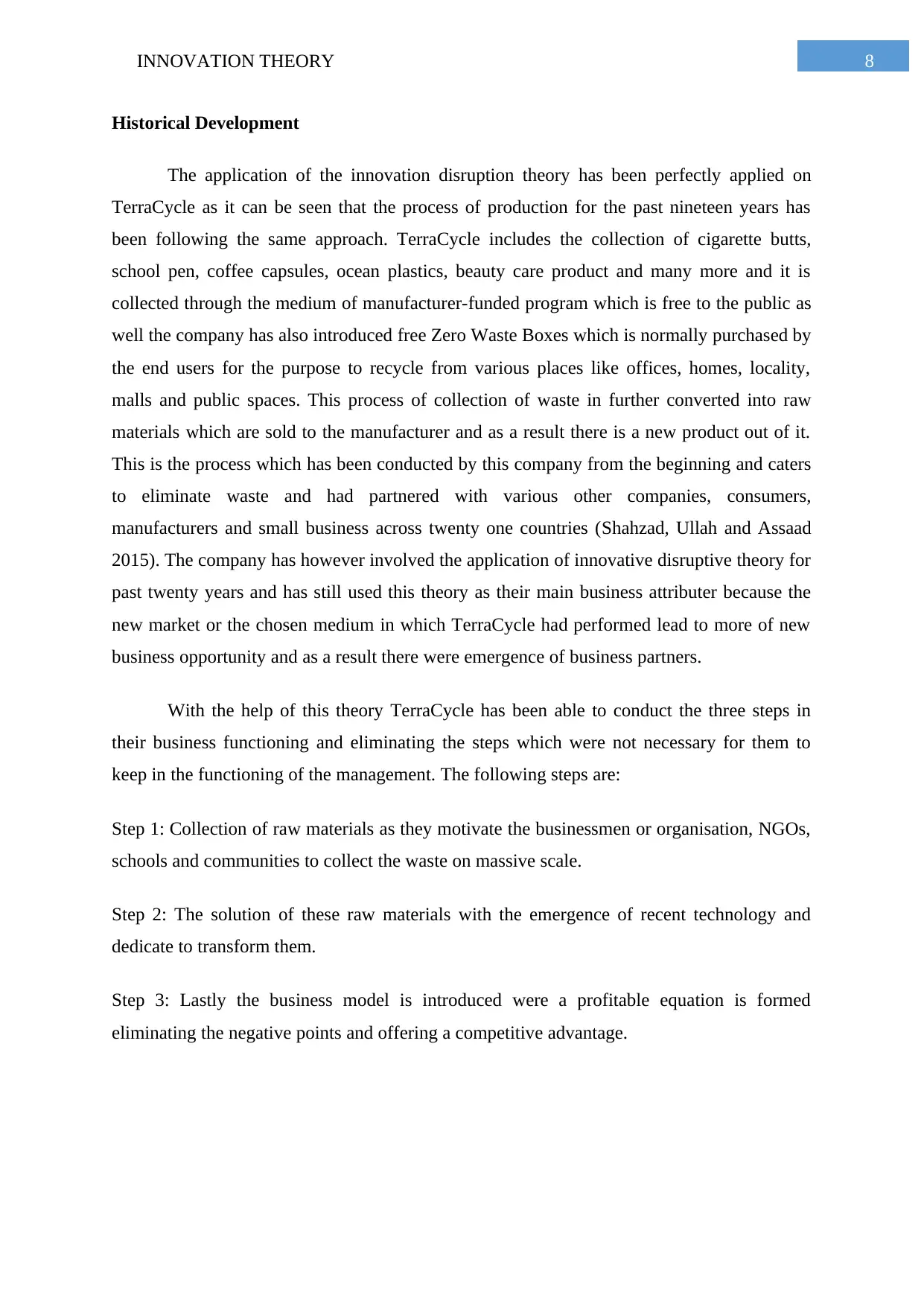
8INNOVATION THEORY
Historical Development
The application of the innovation disruption theory has been perfectly applied on
TerraCycle as it can be seen that the process of production for the past nineteen years has
been following the same approach. TerraCycle includes the collection of cigarette butts,
school pen, coffee capsules, ocean plastics, beauty care product and many more and it is
collected through the medium of manufacturer-funded program which is free to the public as
well the company has also introduced free Zero Waste Boxes which is normally purchased by
the end users for the purpose to recycle from various places like offices, homes, locality,
malls and public spaces. This process of collection of waste in further converted into raw
materials which are sold to the manufacturer and as a result there is a new product out of it.
This is the process which has been conducted by this company from the beginning and caters
to eliminate waste and had partnered with various other companies, consumers,
manufacturers and small business across twenty one countries (Shahzad, Ullah and Assaad
2015). The company has however involved the application of innovative disruptive theory for
past twenty years and has still used this theory as their main business attributer because the
new market or the chosen medium in which TerraCycle had performed lead to more of new
business opportunity and as a result there were emergence of business partners.
With the help of this theory TerraCycle has been able to conduct the three steps in
their business functioning and eliminating the steps which were not necessary for them to
keep in the functioning of the management. The following steps are:
Step 1: Collection of raw materials as they motivate the businessmen or organisation, NGOs,
schools and communities to collect the waste on massive scale.
Step 2: The solution of these raw materials with the emergence of recent technology and
dedicate to transform them.
Step 3: Lastly the business model is introduced were a profitable equation is formed
eliminating the negative points and offering a competitive advantage.
Historical Development
The application of the innovation disruption theory has been perfectly applied on
TerraCycle as it can be seen that the process of production for the past nineteen years has
been following the same approach. TerraCycle includes the collection of cigarette butts,
school pen, coffee capsules, ocean plastics, beauty care product and many more and it is
collected through the medium of manufacturer-funded program which is free to the public as
well the company has also introduced free Zero Waste Boxes which is normally purchased by
the end users for the purpose to recycle from various places like offices, homes, locality,
malls and public spaces. This process of collection of waste in further converted into raw
materials which are sold to the manufacturer and as a result there is a new product out of it.
This is the process which has been conducted by this company from the beginning and caters
to eliminate waste and had partnered with various other companies, consumers,
manufacturers and small business across twenty one countries (Shahzad, Ullah and Assaad
2015). The company has however involved the application of innovative disruptive theory for
past twenty years and has still used this theory as their main business attributer because the
new market or the chosen medium in which TerraCycle had performed lead to more of new
business opportunity and as a result there were emergence of business partners.
With the help of this theory TerraCycle has been able to conduct the three steps in
their business functioning and eliminating the steps which were not necessary for them to
keep in the functioning of the management. The following steps are:
Step 1: Collection of raw materials as they motivate the businessmen or organisation, NGOs,
schools and communities to collect the waste on massive scale.
Step 2: The solution of these raw materials with the emergence of recent technology and
dedicate to transform them.
Step 3: Lastly the business model is introduced were a profitable equation is formed
eliminating the negative points and offering a competitive advantage.
⊘ This is a preview!⊘
Do you want full access?
Subscribe today to unlock all pages.

Trusted by 1+ million students worldwide
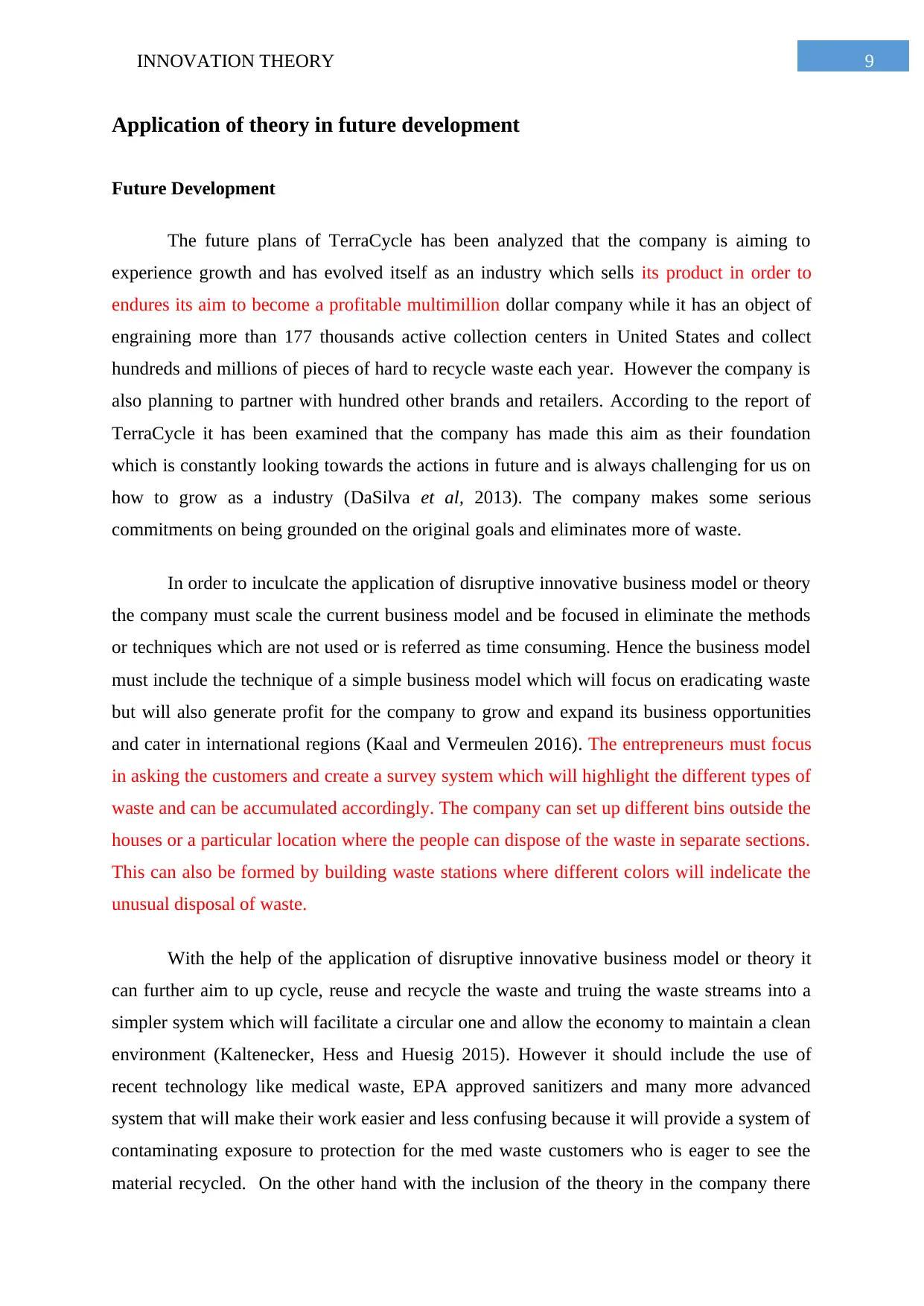
9INNOVATION THEORY
Application of theory in future development
Future Development
The future plans of TerraCycle has been analyzed that the company is aiming to
experience growth and has evolved itself as an industry which sells its product in order to
endures its aim to become a profitable multimillion dollar company while it has an object of
engraining more than 177 thousands active collection centers in United States and collect
hundreds and millions of pieces of hard to recycle waste each year. However the company is
also planning to partner with hundred other brands and retailers. According to the report of
TerraCycle it has been examined that the company has made this aim as their foundation
which is constantly looking towards the actions in future and is always challenging for us on
how to grow as a industry (DaSilva et al, 2013). The company makes some serious
commitments on being grounded on the original goals and eliminates more of waste.
In order to inculcate the application of disruptive innovative business model or theory
the company must scale the current business model and be focused in eliminate the methods
or techniques which are not used or is referred as time consuming. Hence the business model
must include the technique of a simple business model which will focus on eradicating waste
but will also generate profit for the company to grow and expand its business opportunities
and cater in international regions (Kaal and Vermeulen 2016). The entrepreneurs must focus
in asking the customers and create a survey system which will highlight the different types of
waste and can be accumulated accordingly. The company can set up different bins outside the
houses or a particular location where the people can dispose of the waste in separate sections.
This can also be formed by building waste stations where different colors will indelicate the
unusual disposal of waste.
With the help of the application of disruptive innovative business model or theory it
can further aim to up cycle, reuse and recycle the waste and truing the waste streams into a
simpler system which will facilitate a circular one and allow the economy to maintain a clean
environment (Kaltenecker, Hess and Huesig 2015). However it should include the use of
recent technology like medical waste, EPA approved sanitizers and many more advanced
system that will make their work easier and less confusing because it will provide a system of
contaminating exposure to protection for the med waste customers who is eager to see the
material recycled. On the other hand with the inclusion of the theory in the company there
Application of theory in future development
Future Development
The future plans of TerraCycle has been analyzed that the company is aiming to
experience growth and has evolved itself as an industry which sells its product in order to
endures its aim to become a profitable multimillion dollar company while it has an object of
engraining more than 177 thousands active collection centers in United States and collect
hundreds and millions of pieces of hard to recycle waste each year. However the company is
also planning to partner with hundred other brands and retailers. According to the report of
TerraCycle it has been examined that the company has made this aim as their foundation
which is constantly looking towards the actions in future and is always challenging for us on
how to grow as a industry (DaSilva et al, 2013). The company makes some serious
commitments on being grounded on the original goals and eliminates more of waste.
In order to inculcate the application of disruptive innovative business model or theory
the company must scale the current business model and be focused in eliminate the methods
or techniques which are not used or is referred as time consuming. Hence the business model
must include the technique of a simple business model which will focus on eradicating waste
but will also generate profit for the company to grow and expand its business opportunities
and cater in international regions (Kaal and Vermeulen 2016). The entrepreneurs must focus
in asking the customers and create a survey system which will highlight the different types of
waste and can be accumulated accordingly. The company can set up different bins outside the
houses or a particular location where the people can dispose of the waste in separate sections.
This can also be formed by building waste stations where different colors will indelicate the
unusual disposal of waste.
With the help of the application of disruptive innovative business model or theory it
can further aim to up cycle, reuse and recycle the waste and truing the waste streams into a
simpler system which will facilitate a circular one and allow the economy to maintain a clean
environment (Kaltenecker, Hess and Huesig 2015). However it should include the use of
recent technology like medical waste, EPA approved sanitizers and many more advanced
system that will make their work easier and less confusing because it will provide a system of
contaminating exposure to protection for the med waste customers who is eager to see the
material recycled. On the other hand with the inclusion of the theory in the company there
Paraphrase This Document
Need a fresh take? Get an instant paraphrase of this document with our AI Paraphraser
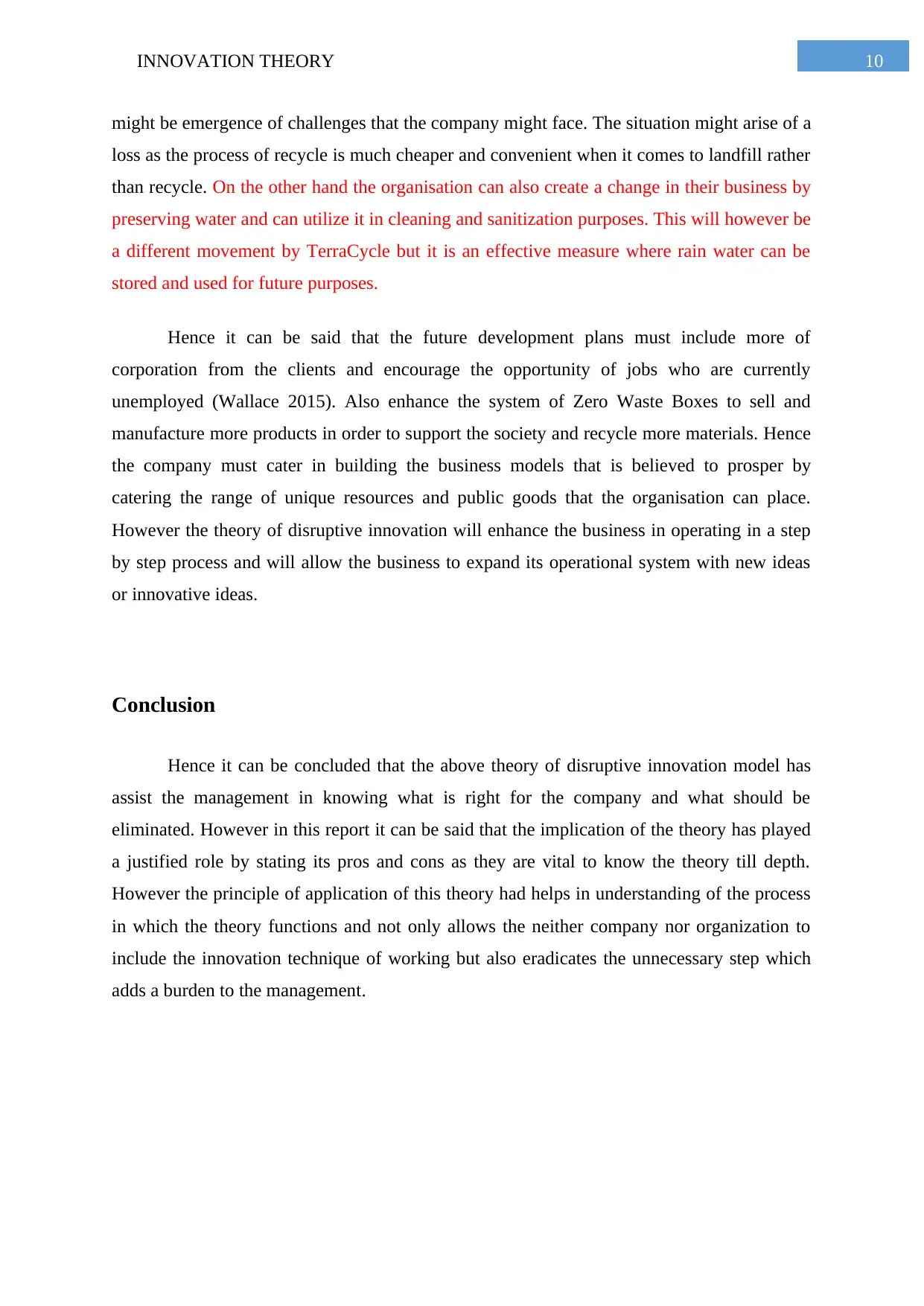
10INNOVATION THEORY
might be emergence of challenges that the company might face. The situation might arise of a
loss as the process of recycle is much cheaper and convenient when it comes to landfill rather
than recycle. On the other hand the organisation can also create a change in their business by
preserving water and can utilize it in cleaning and sanitization purposes. This will however be
a different movement by TerraCycle but it is an effective measure where rain water can be
stored and used for future purposes.
Hence it can be said that the future development plans must include more of
corporation from the clients and encourage the opportunity of jobs who are currently
unemployed (Wallace 2015). Also enhance the system of Zero Waste Boxes to sell and
manufacture more products in order to support the society and recycle more materials. Hence
the company must cater in building the business models that is believed to prosper by
catering the range of unique resources and public goods that the organisation can place.
However the theory of disruptive innovation will enhance the business in operating in a step
by step process and will allow the business to expand its operational system with new ideas
or innovative ideas.
Conclusion
Hence it can be concluded that the above theory of disruptive innovation model has
assist the management in knowing what is right for the company and what should be
eliminated. However in this report it can be said that the implication of the theory has played
a justified role by stating its pros and cons as they are vital to know the theory till depth.
However the principle of application of this theory had helps in understanding of the process
in which the theory functions and not only allows the neither company nor organization to
include the innovation technique of working but also eradicates the unnecessary step which
adds a burden to the management.
might be emergence of challenges that the company might face. The situation might arise of a
loss as the process of recycle is much cheaper and convenient when it comes to landfill rather
than recycle. On the other hand the organisation can also create a change in their business by
preserving water and can utilize it in cleaning and sanitization purposes. This will however be
a different movement by TerraCycle but it is an effective measure where rain water can be
stored and used for future purposes.
Hence it can be said that the future development plans must include more of
corporation from the clients and encourage the opportunity of jobs who are currently
unemployed (Wallace 2015). Also enhance the system of Zero Waste Boxes to sell and
manufacture more products in order to support the society and recycle more materials. Hence
the company must cater in building the business models that is believed to prosper by
catering the range of unique resources and public goods that the organisation can place.
However the theory of disruptive innovation will enhance the business in operating in a step
by step process and will allow the business to expand its operational system with new ideas
or innovative ideas.
Conclusion
Hence it can be concluded that the above theory of disruptive innovation model has
assist the management in knowing what is right for the company and what should be
eliminated. However in this report it can be said that the implication of the theory has played
a justified role by stating its pros and cons as they are vital to know the theory till depth.
However the principle of application of this theory had helps in understanding of the process
in which the theory functions and not only allows the neither company nor organization to
include the innovation technique of working but also eradicates the unnecessary step which
adds a burden to the management.
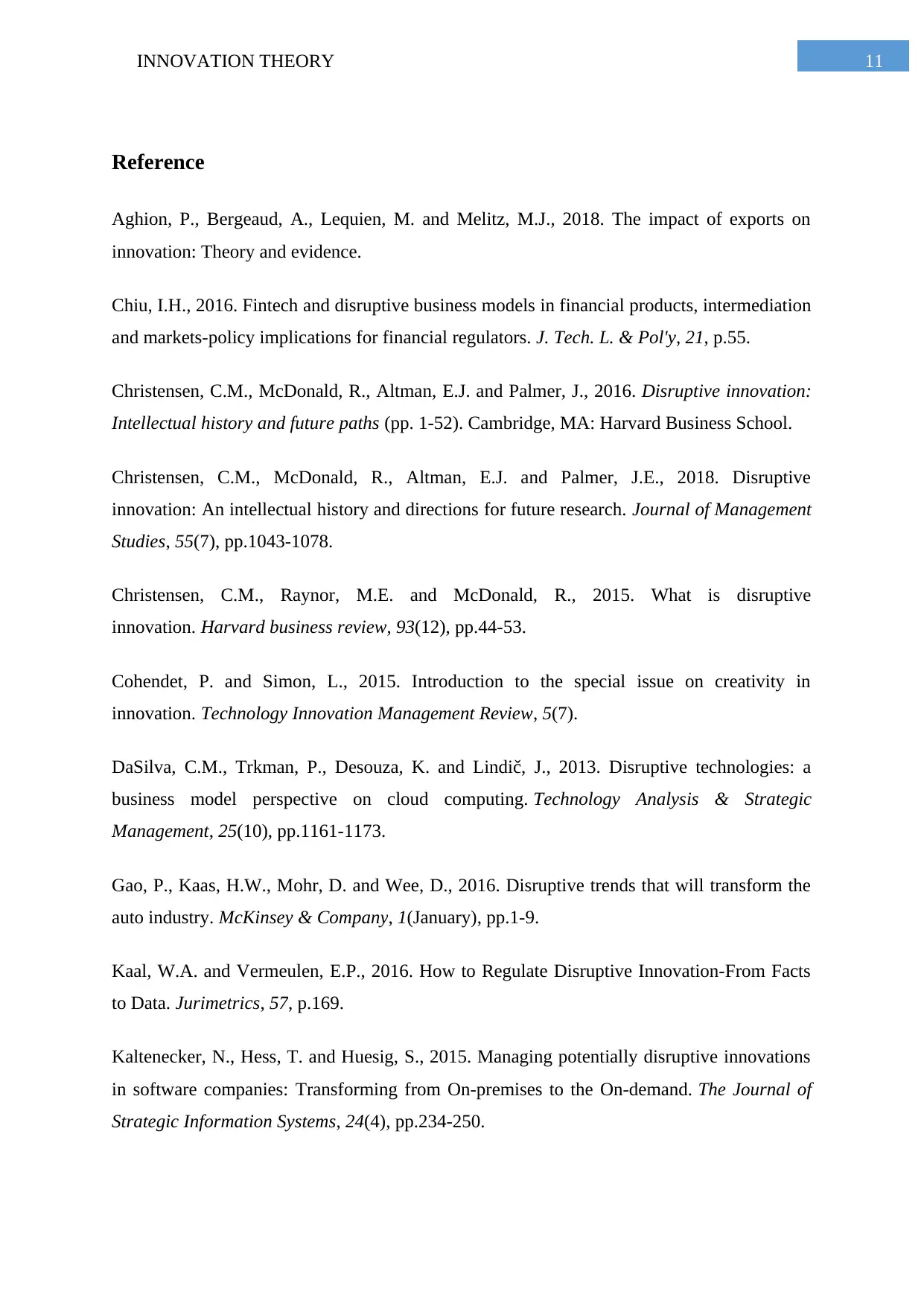
11INNOVATION THEORY
Reference
Aghion, P., Bergeaud, A., Lequien, M. and Melitz, M.J., 2018. The impact of exports on
innovation: Theory and evidence.
Chiu, I.H., 2016. Fintech and disruptive business models in financial products, intermediation
and markets-policy implications for financial regulators. J. Tech. L. & Pol'y, 21, p.55.
Christensen, C.M., McDonald, R., Altman, E.J. and Palmer, J., 2016. Disruptive innovation:
Intellectual history and future paths (pp. 1-52). Cambridge, MA: Harvard Business School.
Christensen, C.M., McDonald, R., Altman, E.J. and Palmer, J.E., 2018. Disruptive
innovation: An intellectual history and directions for future research. Journal of Management
Studies, 55(7), pp.1043-1078.
Christensen, C.M., Raynor, M.E. and McDonald, R., 2015. What is disruptive
innovation. Harvard business review, 93(12), pp.44-53.
Cohendet, P. and Simon, L., 2015. Introduction to the special issue on creativity in
innovation. Technology Innovation Management Review, 5(7).
DaSilva, C.M., Trkman, P., Desouza, K. and Lindič, J., 2013. Disruptive technologies: a
business model perspective on cloud computing. Technology Analysis & Strategic
Management, 25(10), pp.1161-1173.
Gao, P., Kaas, H.W., Mohr, D. and Wee, D., 2016. Disruptive trends that will transform the
auto industry. McKinsey & Company, 1(January), pp.1-9.
Kaal, W.A. and Vermeulen, E.P., 2016. How to Regulate Disruptive Innovation-From Facts
to Data. Jurimetrics, 57, p.169.
Kaltenecker, N., Hess, T. and Huesig, S., 2015. Managing potentially disruptive innovations
in software companies: Transforming from On-premises to the On-demand. The Journal of
Strategic Information Systems, 24(4), pp.234-250.
Reference
Aghion, P., Bergeaud, A., Lequien, M. and Melitz, M.J., 2018. The impact of exports on
innovation: Theory and evidence.
Chiu, I.H., 2016. Fintech and disruptive business models in financial products, intermediation
and markets-policy implications for financial regulators. J. Tech. L. & Pol'y, 21, p.55.
Christensen, C.M., McDonald, R., Altman, E.J. and Palmer, J., 2016. Disruptive innovation:
Intellectual history and future paths (pp. 1-52). Cambridge, MA: Harvard Business School.
Christensen, C.M., McDonald, R., Altman, E.J. and Palmer, J.E., 2018. Disruptive
innovation: An intellectual history and directions for future research. Journal of Management
Studies, 55(7), pp.1043-1078.
Christensen, C.M., Raynor, M.E. and McDonald, R., 2015. What is disruptive
innovation. Harvard business review, 93(12), pp.44-53.
Cohendet, P. and Simon, L., 2015. Introduction to the special issue on creativity in
innovation. Technology Innovation Management Review, 5(7).
DaSilva, C.M., Trkman, P., Desouza, K. and Lindič, J., 2013. Disruptive technologies: a
business model perspective on cloud computing. Technology Analysis & Strategic
Management, 25(10), pp.1161-1173.
Gao, P., Kaas, H.W., Mohr, D. and Wee, D., 2016. Disruptive trends that will transform the
auto industry. McKinsey & Company, 1(January), pp.1-9.
Kaal, W.A. and Vermeulen, E.P., 2016. How to Regulate Disruptive Innovation-From Facts
to Data. Jurimetrics, 57, p.169.
Kaltenecker, N., Hess, T. and Huesig, S., 2015. Managing potentially disruptive innovations
in software companies: Transforming from On-premises to the On-demand. The Journal of
Strategic Information Systems, 24(4), pp.234-250.
⊘ This is a preview!⊘
Do you want full access?
Subscribe today to unlock all pages.

Trusted by 1+ million students worldwide
1 out of 15
Related Documents
Your All-in-One AI-Powered Toolkit for Academic Success.
+13062052269
info@desklib.com
Available 24*7 on WhatsApp / Email
![[object Object]](/_next/static/media/star-bottom.7253800d.svg)
Unlock your academic potential
Copyright © 2020–2025 A2Z Services. All Rights Reserved. Developed and managed by ZUCOL.





